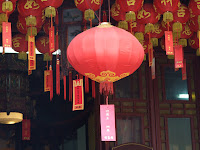


Thursday, July 8
The best thing about the trip was the people. Our guides were the best. They looked after us, kept us safe and laughing and did their best to tell us all they knew about their homes and their histories. Our national guide, Tony, accompanied us all throughout mainland China. He counted us hundreds of times and always made a point of pointing out any “4-star bathrooms” in the area. Best of all, he did his best to teach us Chinese and I will never forget his attempt to teach us “Suzhounese”, which he admitted makes men sound a little “sissy”.
Amy. I met Amy at the Omeida language school in Yangshuo. Omeida is a school, which specializes in immersing its students in English, so that they can improve their communication skills. Chinese tend to do well on the reading and writing intensive tests, but many of them have little or no contact with native speakers and will enroll in schools like Omeida to improve their work prospects by improving their English. Amy, teared up when she told me about Star, her little 17 month-old daughter, whom she left at home when she came to Omeida for 6 months to improve her English.
Stacy. I met Stacy at the private Xi’an Bodi school. Stacy was appointed spokesperson for her group of 4 friends. The star of the class in English, she wrote, “I cannot communicate, what I want to say,” in perfect English grammar. Stacy had too much to say to write it all down and finally began to talk to us. She said that she does not like school and had just learned that a planned summer break had been canceled and replaced by more lessons to prepare for the upcoming year. She was spunky and funny and reminded me very much one of my 7th graders from last year. Something about her smile and her laugh made me think of Carissa on that day in Xi’an.
A family near Xi’an opened their home to us, to let us see how regular folks live. Their granddaughter played with us. They answered our questions and smiled and showed us their simple home with a pride that made it clear that possessions are not the source of happiness.
The people we waited in line with before visiting Mao’s mausoleum, mostly patient, they shaded us with their umbrellas and I watched their solemn faces as they quietly passed by the body of the former Chairman, the father of Communist China. Our “spicy radish” of a tour guide who told us about the tragedy of the Nanjing massacre without an ounce of apology- determined to tell the truth no matter whom it might offend. The shopkeepers. The taxi drivers. The helpful bystanders who helped us flag down the taxi drivers. The worshippers in the temples. The grandparents who doted on all the little emperors and empresses in their care.
Almost without exception, they were gracious and kind and the pictures of their beautiful faces are my favorite souvenir of my three weeks spent in their beautiful country.

















































